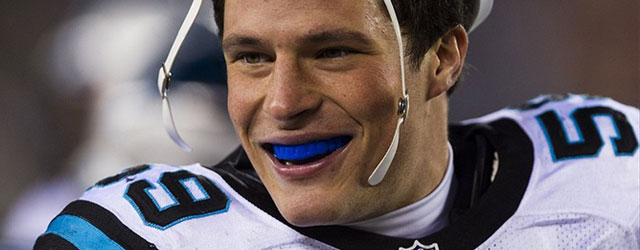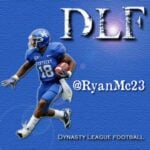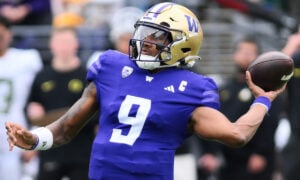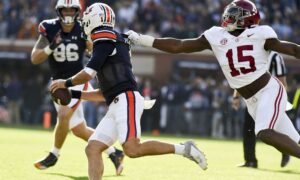Anatomy of a League: Full Impact IDP

Editor’s Note: Make sure you check out the new section of DLF dedicated to the Dynasty World Championship leagues on FFToolbox. You’ll find special player features, start-up draft strategies and much more. Simply look over at the left hand column on the DLF Home page and you’ll see it right underneath the Premium Content. We’ve started with features on Eddie Lacy and Geno Smith.
All dynasty owners are looking for the same thing- a great league to be a part of. But, what makes a dynasty or keeper league successful? How can an owner find (or even create) a league that will be fun, active and competitive? In this ongoing series, I look at some successful dynasty and keeper leagues from the perspective of the commissioners who run the leagues and the owners who participate in them.
Just over a year ago, Steve Gallo, know on Twitter as @SteveGalloNFL, created the Full Impact Dynasty League. As you’ll see, this is a very complex league and is not for the faint of heart, or those who are not truly committed to this game we play. Here’s what Steve, and a few others, had to say about the Full Impact IDP Dynasty League.
League name: Full Impact IDP
Commissioner: Steve Gallo
Assistant Commissioner: TJ Ford
Player Commissioners: John Dent and Dave Colton
Social Media Commissioner: Ross Miles
DLF: How many years has your league been in existence?
SG: Our second season started at 11:59 p.m. ET following the conclusion of SB XLVII. That is when trading opens back up so that is as good a league start date as any. Officially, league dues for the upcoming year aren’t due until the last day in February (11:59 p.m. ET).
DLF: What made you want to create your dynasty league?
SG: It was a concept I had thought about for a few years and have always put on the back burner because there wasn’t a league management site around that could accommodate the complex rules the league has. I finally decided that if we had to do some of the work manually that was what we would do. The reasons for it being a dynasty league are two-fold. One is that I knew that we would need to work some kinks out of the concept, and I wanted to have a commitment from a set of owners and making it a dynasty league gave me that commitment. The other reason is I think a dynasty league is the absolute best way to play fantasy football. Luck is a huge part of fantasy football but a dynasty league mitigates that to some extent. There is much more to it than luck if you are good in a dynasty league year in and year out.
DLF: How did you go about finding owners for your league?
SG: I personally handpicked half of the owners from The Huddle – they are some of the strongest IDP dynasty players I know – and the other half is comprised of industry guys that I recruited via twitter or from other contacts. I needed strong players for this concept but I also wanted the industry guys so that they would help to spread the word about it.
DLF: How many teams do you feel are ideal for a dynasty league?
SG: For most, that answer is probably 12 teams, but for me I absolutely love 16 team leagues. Again, I like to find ways to minimize the luck aspect of the game and 16 teams does just that.
DLF: What are the starting lineups your league uses?
SG: Our starting lineups are a bit different. The biggest difference on the offensive side of the ball is that you don’t have to start a running back, but can start as many as three if you want. On the IDP side, we actually have to start true NFL defensive sets. I hope that in the near future, MFL will designate defensive players with their true positions so we can actually require teams to start one WLB, one MLB and one SLB if they are using a 4-3 defense. For now, we’ll have to settle for just any three LBs. Here is a complete list of our starting lineups:
Offense: 9 Starters with the following options being valid lineups*:
QB 1
RB 0-3
WR 0-5
TE 1-3
PN 1
PK 1
*A combination of 6 RB/WR/TE, not to exceed the maximum limits per position.
Defense: 11 Starters with the following options being valid lineups*.
3-4
#1 DE2, DT1, LB4, CB2, S2
4-3
#2 DE2, DT2, LB3, CB2, S2
Nickel(3-3-5, 4-2-5 or “Big Nickel”)
#3 DE2, DT1, LB3, CB3, S2
#4 DE2, DT2, LB2, CB3, S2
#5 DE2, DT2, LB2, CB2, S3
Dime (4-1-6)
#6 DE2, DT2, LB1, CB4, S2
Prevent (3-1-7 or 4-0-7)
#7 DE2, DT1, LB1, CB4, S3
#8 DE2, DT2, LB0, CB4, S3
8 in the Box (4-4-3)
#9 DE2, DT2, LB4, CB2, S1
Goal line (5-4-2)
#10 DE2, DT3, LB4, CB2, S0
DLF: Does your league have any unique rules?
SG: You are probably going to get more than you bargained for with this question. The answer is a resounding yes (Link to our rules). For starters, we have what I refer to as Full Impact Scoring. In short, the defensive set you start impacts your opponents offensive players scores both positively and negatively. Here is what our Full Impact Scoring looks like:
Your opposition’s offensive scores will be adjusted based on the defensive alignment that you start.
The following defensive alignments indicate how the listed positions will be adjusted.
3-4
#1 DE2, DT1, LB4, CB2, S2……QB: -5%,RB: +10%, WR: -5%, TE: n/a
4-3
#2 DE2, DT2, LB3, CB2, S2……QB: +5%, RB: -10%, WR: n/a, TE: +5%
Nickel(3-3-5, 4-2-5 or “Big Nickel”)
#3 DE2, DT1, LB3, CB3, S2……QB: -5%, RB: +10%, WR: -5%, TE: n/a
#4 DE2, DT2, LB2, CB3, S2……QB: -10%, RB: +10%, WR: -10%, TE: +10%
#5 DE2, DT2, LB2, CB2, S3……QB: -5%, RB: +5%, WR: +5%, TE: -5%
Dime (4-1-6)
#6 DE2, DT2, LB1, CB4, S2……QB: -10%, RB: +30%, WR: -10%, TE: -10%
Prevent (3-1-7 or 4-0-7)
#7 DE2, DT1, LB1, CB4, S3……QB: -15%, RB: +40%, WR: -15%, TE: -10%
#8 DE2, DT2, LB0, CB4, S3……QB: -30%, RB: +50%, WR: -30%, TE:+10%
8 in the Box (4-4-3)
#9 DE2, DT2, LB4, CB2, S1……QB: +20%, RB: -40%, WR: +20%, TE: n/a
Goal line (5-4-2)
#10 DE2, DT3, LB4, CB2, S0……QB: +30%, RB: -50%, WR: +10%, TE: +10%
An offensive player can score negative points, and if they do score negative points then “full impact adjustments” will not be made to that players score. Simply put, if a player scores negative points then they stay the same.
We also have a Franchise Tag that is crafted differently than any other I have ever seen (I created it for another league I am in called Any Time Any Place). The cost to give a player the Franchise Tag is $30 (league money that is used for blind bids/FCFS waivers too). At that point, you are guaranteed to keep said player but his contract will be a one-year deal only. However, the twist is that there is a closed blind bid session where all owners can submit offers for franchised players. The owner of the tagged player gets to decide if he wants to keep the player or let him go for a compensation package of his choosing. As far as the compensation packages go they can be comprised of league cash, players and draft picks. In most leagues I have been in compensation was reserved to a draft pick or pick and cash. I think that a team should be able to utilize all their resources, which is why I crafted the rule the way that I did. Also, a team can make offers for multiple Franchise Tagged players, but they can’t offer up the same player, pick or cash that when added up would exceed their budget. That is so that a team can’t just try to put a big package together and send it out for all the franchised players. Instead, they have to make hard decisions on who and how to make offers. The entire Franchise Tag rule can be found HERE (6.6).
We also have RFA (restricted free agency), Blind Bid and First-Come First-Serve Waivers. FCFS waivers might seem a bit odd for a dynasty league but I wanted to find a way to help with those last minute injuries that you just don’t get enough information on early in the week. FCFS is really just an emergency waiver process because if a player is picked up in FCFS he must be used in the starting lineup that week and he automatically is assigned a one-year contract and is not eligible to be franchised. The cost is also steep at $5 (league money, we get $100/yr). In our first year, I think we had a total of five FCFS waiver acquisitions. Lastly, the most unique rule we don’t have yet but will as soon as I can get MFL to change how they designate players is that on the IDP side, teams will have to start real defensive schemes. By that I mean if they start a 4-3 they will have to start 2DE’s , 2DT’s, 1WLB, 1MLB, 1SLB, 2CB’s, 1FS and 1SS and in a 3-4 they would have to start 2DE’s, 1DT, 2rOLB’s(rush), 2ILB’s(must be 3-4 LBs), 2CB’s, 1FS and 1SS. My fingers are crossed that MFL starts designating players with their proper positions.
DLF: How are divisions setup in your league?
SG: We have two divisions with four teams each in both conferences.
DLF: How is the rookie draft handled? Any special rules or features?
SG: A non-serpentine drafted with the order set from worst to best based on the previous year’s results. The ten teams that don’t make the playoffs are seeded by record (total points as tie breaker) and the remaining teams are seeded based on their finish in the playoffs.
DLF: How did you go about creating rules that has resulted in a successful league?
SG: I have been in dynasty leagues at the huddle for over ten years, so I replicated rules I felt worked, tweaked ones I felt needed to be tweaked and crafted additional ones I felt would make the league great.
DLF: What are some of the specific rules you have that makes your league unique and successful?
SG: I already touched on our multitude of unique rules so that leaves touching on the successful part. I think the important part is to have a very thorough and well thought out set of rules. If you have a strong set of rules, the commissioner’s job should be a relatively easy one.
DLF: How do you handle controversy in your league? Can you give me an example?
SG: If something isn’t spelled out in our rules and a commissioner ruling is needed, a decision is made and posted in our forum. At that point, you might think that is the end of it, but it isn’t. A commissioner ruling can be brought up for a vote if two owners request a league-wide vote (requires nine of 16 votes to overturn a commissioner ruling). We haven’t really had any controversy. The closest would have been allowing an owner to make a change to their declared roster after the deadline had passed last year. The rules are clear with deadline dates, but one of the industry guys misunderstood a rule and I allowed him to tweak his contracts after the deadline (fine free). This is where as a commissioner you have to understand the spirit of the rules and let that guide you in your decision. Since there was no advantage gained, I allowed the adjustment, but I still sent out an email to the league telling them my intention and asking if anyone had any reservations about what I was going to do. Communication is key!
DLF: Are league decisions made solely by you, or does that league vote on issues?
SG: It depends. If it isn’t covered in the rules I will make a ruling. However, as I pointed out the league can call me to task and bring that ruling to a vote. We also have the following rule for rule(s) changes:
1.6.1 Rule Changes
League Rules will be reviewed annually during the month of March. Major rule changes can only be made through a league-wide vote requiring 75% yes votes for passage with a minimum of 12 votes being cast. In-season votes, though discouraged, requires 12 yes votes to pass.
We also have a “Conduct Detrimental” rule that with 12 votes an owner can be removed from the league. Just make sure you surround yourself with good owners and that rule will never come into play. We also have a rule that states the league will vote on replacement owners on the off chance we lose an owner.
DLF: What is something that could ruin an otherwise strong league?
SG: Fighting and bickering. Smack talk is one thing, just realize that that line can get blurred and if owners cross it things can go south real fast. A lack of consistency with regards to rulings can also do a league in.
DLF: What are the main reasons your league has become so successful?
SG: The owners. In every league I have ever been in, the owners have been the reason a league was successful or not.
DLF: How many leagues do you commish?
SG: Currently Full Impact IDP is the only true fantasy football league that I commish but I am also running my new concept — The Ultimate Drafter Series.
Next, I contacted some of those great owners that make up the Full Impact IDP league to collect their thoughts about what makes theirs such a strong league.
Jim McCormick
DLF: Is there a rule or feature that sets this league apart from others?
JM: The main differentiating factor with this league is the sheer scale and complexity of it. That, and the fact that individual defenders are rightfully valued as key assets.
DLF: What are some things the commissioner does or has done to help create a strong league?
JM: Steve really thought this out and structured a league that tries to mimic some of the real considerations a scenarios a professional front office experiences.
DLF: Overall, what are the main reasons this league has become successful?
JM: A good group of veteran IDP nerds are competing in an ongoing and in-depth league, what’s not to like? But really, the league is successful because it demands that you really know the rosters around the league and thus the competition is heightened.
Ross Miles (@PFF_RossMiles)
DLF: Is there a rule or feature that sets this league apart from others?
RM: The unique scoring system that is defensive scheme dependent makes this league very different to all others I play in.
DLF: What are some things the commissioner does or has done to help create a strong league? RM: The league is 50/50 “pros” and “joes” which makes for an interesting dynamic. We also have a dedicated forum to make sure everyone is aware of any moves or changes within the league.
DLF: Overall, what are the main reasons this league has become successful?
RM: A combination of the unique scoring and line-up requirements that add a level of tactical complexity.
Steve Wyremski (@SteveWyremski)
DLF: Is there a rule or feature that sets this league apart from others?
SW: In this league, your defensive formation actually has an impact on your opponents offensive output. For example, say that you’re opponent has Aaron Rodgers and a number of top tier wide receivers and no running backs, you can submit a defensive lineup that is a “prevent” formation and significantly reduce the points from the QB/WRs. The beauty is that you MUST submit a valid defensive formation and opponents can’t see the other’s lineup until all games for the week have started.
In the first season, we’ve all decided that the defensive impact on the offensive output needs to be increased, but the format is phenomenal and a great concept created by Steve Gallo.
This is probably the most significant, but we also have restricted free agency and franchise tag ability each season that goes along with contracts for all players. Ultimately, this league is the as close to an NFL mirror that can be found.
DLF: What are some things the commissioner does or has done to help create a strong league?
SW: He’s recruited a mix of both “experts” and “regular” owners. In addition, like I mentioned above, this league mirrors the NFL game as much as possible. It’s a unique league that has all consistently interested.
DLF: Overall, what are the main reasons this league has become successful?
SW: The commish. Steve and his co-commish are always engaged and keeping the league apprised of league happenings.
If you are part of a unique dynasty league, contact @RyanMc23 on Twitter to share more about it, and maybe be featured in a future “Anatomy of a League.”
- Monday Mocks: Expert 2024 Rookie Mock Draft - April 22, 2024
- Monday Mocks: 2024 Landing Spots - April 15, 2024
- Five Landing Spots That Would Tank Rookie WR Value - April 13, 2024


































































